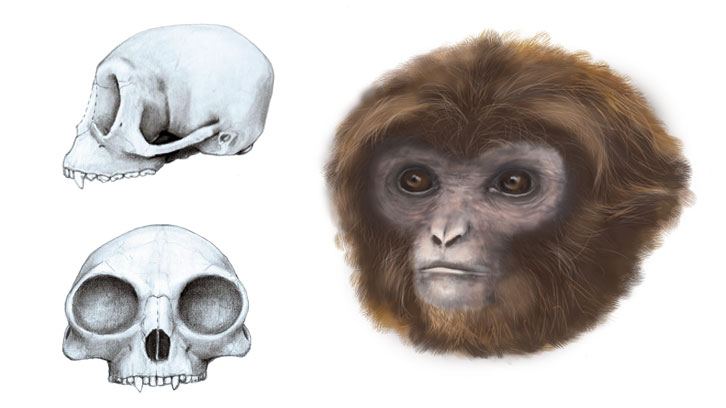Pliobates cataloniae, a new primate species at the root of the tree of extant hominoids

Living hominoids are a group of primates that includes the small-bodied apes (the lesser apes, or gibbons and siamangs, which constitute the family Hylobatidae) and the larger-bodied great apes (orangutans, gorillas and chimpanzees), which, along with humans, belong to the family Hominidae. All extant hominoids share several features, such as the lack of external tail, an orthograde body plan that enables an upright trunk position, and several cranial characteristics. All these features might have been present in the common ancestor of hominids and hylobatids that, according to molecular data, would have lived about 15-20 million years ago.
|
|
|
| Figure 1: Main cranial fragment of Pliobates cataloniae. Source: ICP. | |
This find radically changes the hitherto accepted morphotype of the hylobatid-hominid ancestor and provides very solid clues about the origin of extant gibbons. “The origin of gibbons is a mystery because of the lack of fossil record, but until now most scientists thought that their last common ancestor with hominids must have been large, because all of the undoubted fossil hominoids found so far were large-bodied", explains David M. Alba, the ICP researcher leading the study published in the journal Science. All the small-bodied (5 to 15 kg) fossil anthropoids found before Pliobates displayed a body plan too primitive to be closely related to extant hominoids. “This find overturns everything”, according to this ICP researcher.
|
|
|
| Figure 2: Long bones from the left arm of Pliobates cataloniae. Humerus (A), radius (B) and ulna (C). Source: ICP. | |
In fact, the skull and some parts of the postcranial skeleton of Pliobates cataloniae show some features that are exclusive to extant gibbons. “This suggests that, alternately, Pliobates might be the sister group of extant gibbons only", asserts Salvador Moyà-Solà, ICREA researcher and director of the ICP, who also participated in the study. “We hope that future discoveries in the landfill of Can Mata will help us to clarify the role played by small-bodied catarrhines in hominoid evolution and, finally, to solve the enigma of extant gibbons’ origins”, concludes Moyà-Solà.
The adaptations of the postcranial skeleton of Pliobates cataloniae are indicative of a locomotor repertoire mostly consisting in slow and cautious climbing through the canopy, with a great flexibility of movement and some capacity ofbelow-branch suspension. Its encephalization degree was similar to that of living monkeys and gibbons, but lower than that of living great apes. Microscopic marks left by food items on the occlusal surfaces of its teeth shortly before death indicate an essentially frugivorous diet (i.e., based mainly on ripe and soft fruit), like in living gibbons.
The cranial remains were so fragmentary that researchers relied on a virtual reconstruction based on high-resolution computed-tomography imagery to study them.
Figure 3: The skull of Pliobates has been virtually reconstructed based on high-resolution scans. Frontal (A), side (B) and basal (C) views are shown. Source: ICP.
The name of the new genus (Pliobates) is a combination of Pliopithecus (which means “more ape”) and Hylobates (“the one who walks or haunts”), in allusion to the primitive similarities with other previously-known small-bodied anthropoids (pliopithecoids) and the resemblances, in derived features, with extant gibbons (hylobatids). The species epithet (cataloniae) is a geographical reference the location of the site in Catalonia. The specimen has been nicknamed “Laia”, a familiar diminutive of “Eulalia”, the patron of Barcelona, which literally means “well spoken, eloquent” because of the new knowledge that means to science.
Abocador de Can Mata, an exceptional site
The finding of Pliobates proves once again that the complex of sites at Abocador de Can Mata is one of the most important places worldwide to study the origin of extant hominoids. The paleontological surveillance performed during the enlargement of the landfill over the last 13 years, under the scientific supervision of the ICP, has enabled the recovery of extraordinary fossil primate remains from 12.5 to 11.5 million years ago. Most noteworthy are the skeleton of Pierolapithecus catalaunicus (known as “Pau”), found in 2002 and described in 2004, as well as the skull of Anoiapithecus brevirostris (“Lluc”), described in 2009.
Figure 4: Panoramic view of the works in the Can Mata landfill (els Hostalets de Pierola). The site where the remains of the new hominoid were found is shown on the left. Source: J.M. Robles / ICP.
|
|
|
| Figure 5: Representation of the environment and some of the species that inhabited the area of els Hostalets de Pierola about 12 million years ago. Source: Oscar Sanisidro / ICP. | |
More information in this video.
References
Alba, D. M.; Almécija, S.; DeMiguel, D.; Fortuny, J.; Pérez de los Ríos, M.; Pina, M.; Robles, J.M.; Moyà-Solà, S. A new Miocene small-bodied ape from Eurasia sheds light on hominoid evolution. Science. 2015, vol. 350, aab2625. doi: 10.1126/science.aab2625.

